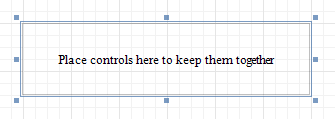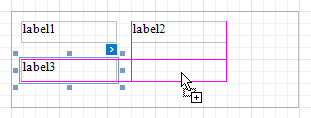Panel
The Panel control is a container that frames separate report controls to allow them to be easily moved, copied and pasted, and visually unite them in the report's preview (with borders or a uniform color background).

Currently, there are several limitations on panel usage. One of them is that panels cannot shrink, and therefore cannot suppress the white space that appears when the controls inside are shrunk or collapsed. Also, the panel cannot cross bands, as the Cross-band Line and the Cross-band Box can do.

In the Property Grid, the panel's properties are divided into the following groups.
| Property | Description |
|---|---|
| Background Color | Specifies the background color for the control. |
| Borders, Border Color, Border Dash Style and Border Width | Specify border settings for the control. |
| Formatting Rules | Opens the Formatting Rules Editor allowing you to choose which rules should be applied to the control during report generation, and define the precedence of the applied rules. To learn more on this, see Conditionally change a control's appearance. |
| Padding | Specifies indent values which are used to render the contents of controls contained in a panel. |
| Style Priority | Allows you to define the priority of various style elements (such as background color, border color, etc.). For more information on style inheritance, see Understand styles concepts. |
| Styles | This property allows you to define odd and even styles for the control, as well as to assign an existing style to the control (or a newly created one). For more information on style inheritance, see Understand styles concepts. |
| Property | Description |
|---|---|
| Anchor Horizontally |
Specifies the horizontal anchoring style of the control, so that after page rendering it stays attached to the left control, right control, or both. Note that if the Anchor Horizontally property is set, the Can Grow property (see below) values are ignored, and don't participate in calculating a final width value of this control. |
| Anchor Vertically |
Specifies the vertical anchoring style of the control, so that after page rendering it stays attached to the top control, bottom control, or both. Note that if the Anchor Vertically property is set to Bottom or Both, the Can Grow property (see below) values are ignored, and don't participate in calculating a final height value of this control. |
| Can Grow | When this property is set to Yes, the control's height can be automatically increased, if required, to display the text. If there are other controls below the current control, they will be pushed down to prevent them from overlapping. Note that if a control overlaps the growing panel by even one pixel, it will not be pushed down by the growing panel. |
| Keep Together | Specifies whether the contents of the control can be horizontally split across pages. In other words, if the control occupies more space than remains on the page, this property specifies whether this control should be split between the current page and the next, or whether it will be printed entirely on the next page. This property is in effect only when the control's content does not fit on the current page. If it does not fit on the next page either, then the control will be split despite this property's value. |
| Scripts | This property contains events, which you can handle with the required scripts. For more information on scripting, see Handle events via scripts. |
| Visible | Specifies whether the control should be visible in Print Preview. |
| Property | Description |
|---|---|
| (Data Bindings) | This property allows you to bind some of the control's properties (Bookmark, NavigateURL and Tag) to a data field obtained from the report's data source, and to apply a format string to it. |
| Tag |
This property allows you to add some additional information to the control; for example its id, by which it can then be accessible via scripts. The Tag property can be bound to a data field obtained from the data source. To do this, expand the (Data Bindings) property and in the Tag.Binding drop-down selector, select the required data field. |
| Property | Description |
|---|---|
| (Name) | Determines a control's name, by which it can be accessed in the Report Explorer, Property Grid or via scripts. |
| Property | Description |
|---|---|
| Location | Specifies the control's location, in report measurement units. |
| Size | Specifies the control's size, in report measurement units. |
| Snap Line Margin | Specifies the margin (in report measurement units), which is to be preserved around the control when it is aligned using Snap Lines, or when other controls are aligned next to it. |
| Snap Line Padding | Specifies the padding (in report measurement units), which is to be preserved within the control when controls it contains are aligned using Snap Lines. |
| Property | Description |
|---|---|
| Bookmark and Parent Bookmark |
These properties are intended for the creation of a hierarchical structure within a report called a document map. For an explanation and help, see Add bookmarks. The Bookmark property can be bound to a data field obtained from the data source. To do this, expand the (Data Bindings) property and in the Bookmark.Binding drop-down selector, select the required data field. |
| Navigation URL and Target |
Use the Navigate URL property to specify a URL for web browser navigation when a user clicks on the control. The web browser displays a page in a window or a frame as specified by the Target property. Note that a URL should have an appropriate prefix (e.g. "http://"). You can create cross-references within the report by assigning the name of the target control to the Navigate URL property, and setting the Target property to "_self". For more information, see Create hyperlinks. The Navigate URL property can be bound to a data field obtained from the data source. To do this, expand the (Data Bindings) property and in the Navigate URL.Binding drop-down selector, select the required data field. |
